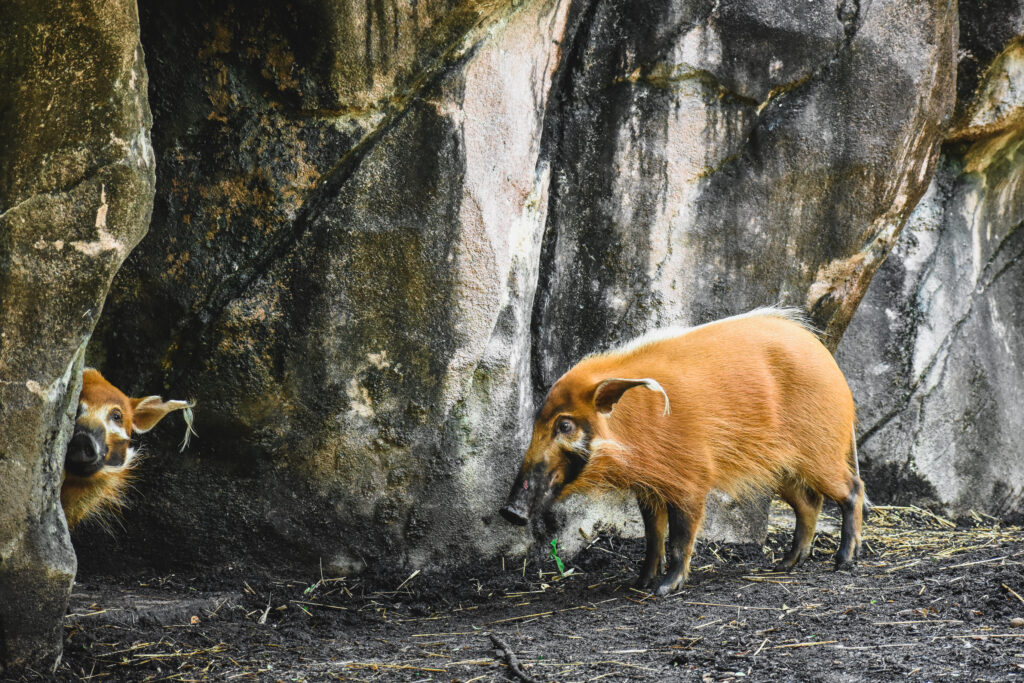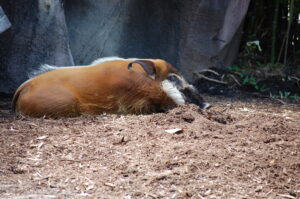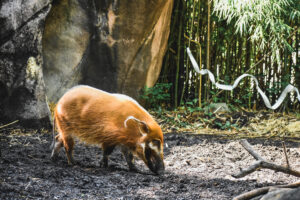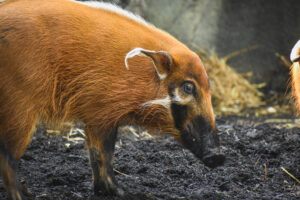Like Fine Swine
Just beyond the African Village Cafe at the Virginia Zoo, across from the vast exhibit where the Masai giraffes, Yellow-backed duikers, Southern ground hornbills and ostrich live, Zoo visitors are seeing red – no really, you can see a red-colored animal. They even have “red” in their name. They’re the Red river hogs!

Often mistaken for their relatives – the warthogs, these pigs are just one of many wild hog species. They are, on average, the smallest wild hog species in Africa, growing between two to three feet in height and weighing up to 270 pounds.
Red river hogs are also known as bush pigs and earned both names from their looks and the type of habitat they are found in. The hogs all have a red coat and are found in rainforests, dry forests and areas with abundant brush in west and central Africa. They often prefer areas with a water supply, such as near a river or stream in which they can wallow in mud.
These pigs can get pretty dirty…and stinky too! They are notorious for using their tusks to scrape tree trunks then scent marking their territory. When another hog invades their territory, the hogs may spar with one another. It is believed that the pads on their snouts protect from another hog’s tusks when sparring.
Red river hogs have an excellent sense of smell and use their noses to burrow down into the ground in search of food. They are mixed feeders, often consuming roots, fruit, seeds, crops, grasses, nuts, insects, bird eggs, snails, reptiles and carrion.
This species is listed as a least concern on the International Union for Conservation of Nature’s Red List of Endangered Species, however there is a decline in the species population. Increasing human encroachment is a threat for this species, which is now one of the most hunted species in the Congo basin. Another threat is habitat loss.
The Virginia Zoo is one of several zoological institutions that participates in a Species Survival Plan ® (SSP) for Red River Hogs. This program is run by the Association for Zoos and Aquariums (AZA), and oversees and manages species’ population in zoos by pairing individuals and monitoring breeding to maximize genetic diversity and long-term sustainability of populations. The SSP also ensures the species’ survival in the wild through supporting conservation efforts such as programs that protect or restore habitats.
The Zoo has its very own sounder, or family group, of Red river hogs – male Oboi and females Mrembo and Tikiti.
 Oboi was born on March 27, 2007 at the San Diego Zoo in California. In February 2012, he made the long journey to the Virginia Zoo as part of the SSP. Oboi spends his days training with and getting scratches from his Keepers, who use a back scratcher tool to complete the task. He also can be found digging around in the exhibit, napping with the girls and enjoying enrichment items. He enjoys food such as hard boiled eggs, grain and apple, and items such as perfume sprayed around his exhibit and on boxes or paper bags. Keepers say Oboi is very intelligent and eager to train with them!
Oboi was born on March 27, 2007 at the San Diego Zoo in California. In February 2012, he made the long journey to the Virginia Zoo as part of the SSP. Oboi spends his days training with and getting scratches from his Keepers, who use a back scratcher tool to complete the task. He also can be found digging around in the exhibit, napping with the girls and enjoying enrichment items. He enjoys food such as hard boiled eggs, grain and apple, and items such as perfume sprayed around his exhibit and on boxes or paper bags. Keepers say Oboi is very intelligent and eager to train with them!
 Mrembo, or Remy for short, was born on April 14, 2017 at the San Diego Safari Park and has been at the Virginia Zoo since May 2019. She enjoys eating the same food as Oboi, but would much rather play with cardboard boxes than sniff around the exhibit like Oboi. Remy can often be seen. exploring the lower part of the exhibit, known as the moat, or napping in the sun with Oboi and her sister, Tikiti.
Mrembo, or Remy for short, was born on April 14, 2017 at the San Diego Safari Park and has been at the Virginia Zoo since May 2019. She enjoys eating the same food as Oboi, but would much rather play with cardboard boxes than sniff around the exhibit like Oboi. Remy can often be seen. exploring the lower part of the exhibit, known as the moat, or napping in the sun with Oboi and her sister, Tikiti.

Known as Tiki for short, Tikiti is the sister of Remy and shares the same birthplace and birthday. In fact, it appears the sisters share many of the same interests, but Tiki has a special talent – she loves hanging around the pool, submerging her snout underwater and blowing bubbles!
Keepers say all three hogs are very intelligent and eager to train with them! Want to see a training session in person? On a behind-the-scenes tour with the Red river hogs, visitors will have the opportunity to get a closer look, ! Learn more about these amazing animals, and what it takes to care for them from their Zoo Keepers.